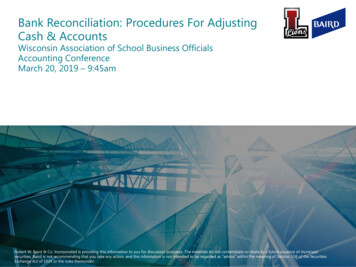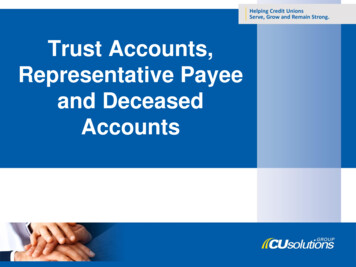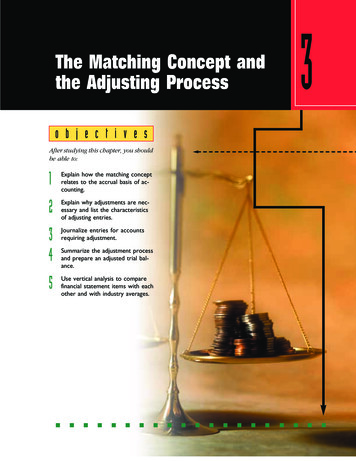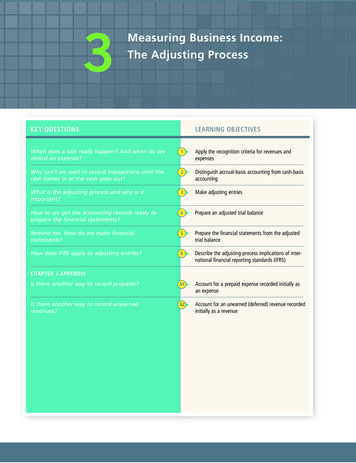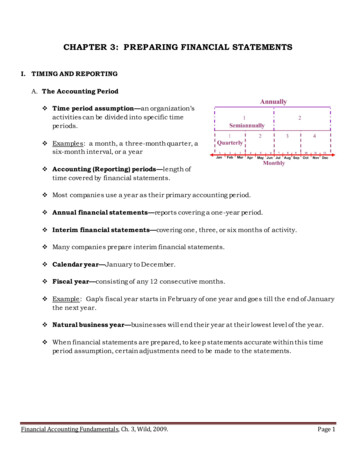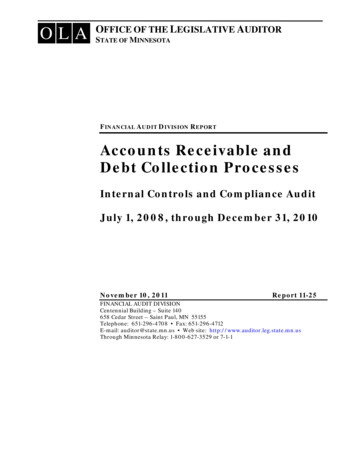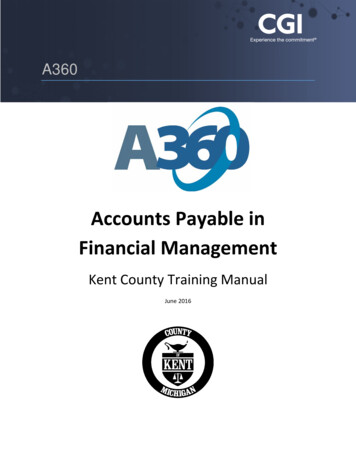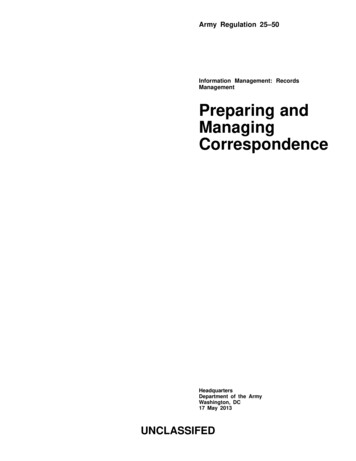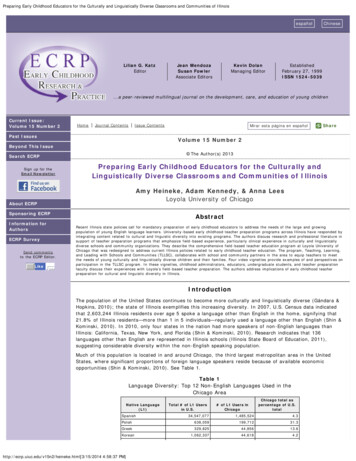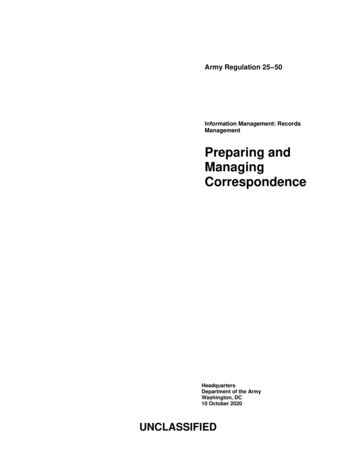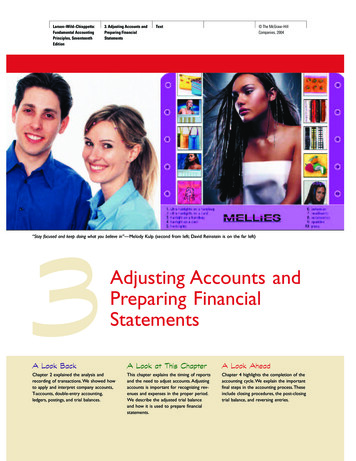
Transcription
Larson Wild Chiappetta:Fundamental AccountingPrinciples, SeventeenthEdition3. Adjusting Accounts andPreparing FinancialStatements The McGraw HillCompanies, 2004Text“Stay focused and keep doing what you believe in”—Melody Kulp (second from left; David Reinstein is on the far left)3Adjusting Accounts andPreparing FinancialStatementsA Look BackA Look at This ChapterA Look AheadChapter 2 explained the analysis andrecording of transactions. We showed howto apply and interpret company accounts,T-accounts, double-entry accounting,ledgers, postings, and trial balances.This chapter explains the timing of reportsand the need to adjust accounts. Adjustingaccounts is important for recognizing revenues and expenses in the proper period.We describe the adjusted trial balanceand how it is used to prepare financialstatements.Chapter 4 highlights the completion of theaccounting cycle. We explain the importantfinal steps in the accounting process. Theseinclude closing procedures, the post-closingtrial balance, and reversing entries.
Larson Wild Chiappetta:Fundamental AccountingPrinciples, SeventeenthEdition3. Adjusting Accounts andPreparing FinancialStatements The McGraw HillCompanies, 2004TextLearning ObjectivesCAPConceptualAnalyticalProceduralthe importance of periodicC1 Explainreporting and the time periodhow accounting adjustmentsA1 Explainlink to financial statements. (p. 104)profit margin and describeA2 Computeits use in analyzing companyand explain adjustingP1 Prepareentries. (p. 97)and prepare an adjusted trialP2 Explainbalance. (p. 105)financial statements from anP3 Prepareadjusted trial balance. (p. 106)principle. (p. 94)accrual accounting and howC2 Explainit makes financial statements moreperformance. (p. 108)useful. (p. 95)the types of adjustments andC3 Identifytheir purpose. (p. 97)Decision FeatureSparkling FinancialsEL SEGUNDO, CA—One afternoon 23-year-oldThe young entrepreneurs learned a lot in a hurry. She had to meetMelody Kulp was playing outside with the youngcreditors and bankers, set up a reliable accounting system, draw upcousin of a friend when she placed yard-picked flow-financial statements, and analyze and interpret financial data. It was aters in the girl’s hair and thought how much prettier they lookedtimes overwhelming, says Kulp, but “the key is to stay focused andthan headbands or hair clips. The next day, with some silk flowerskeep doing what you believe in.”and Velcro she purchased, Kulp made similar hair accessories, calledthem Sparkles, and began wearing them.When a friend wore one to work at Fred Segal’s, the shop’sbuyer asked to meet with Kulp about putting together aproduct line. Kulp quickly organized a business—dubbed MelliesKulp knows how important a timely and reliable accounting system is for Mellies’ continued success. Historical and projected financial statements have enabled her company to obtain the necessaryfinancing to propel it to new heights.This chapter focuses on the accounting system underlying finan-(Mellies.com)—and then converted a 10¿ 10¿ room in hercial statements. Says Kulp, “We’ve got the system set up where wehouse into a minifactory. The rest is the stuff of Hollywood movies.can look ahead, rather than live day to day.” That look ahead revealsAfter only three years, Mellies is a 40 million accessoriescompany. With her 25-year-old partner David Reinstein, Melody Kulpnow manages 15 employees and plans to launch a cosmetics line.sparkling financials.[Sources: Mellies Website, January 2004; Success Publishing, 2000; Entrepreneur,November 2000.]
Larson Wild Chiappetta:Fundamental AccountingPrinciples, SeventeenthEdition3. Adjusting Accounts andPreparing FinancialStatements The McGraw HillCompanies, 2004TextChapter PreviewFinancial statements reflect revenues when earned and expenses when incurred. This is known as accrual accounting.Accrual accounting requires several steps. We described manyof these steps in Chapter 2. We showed how companies useaccounting systems to collect information about externaltransactions and events. We also explained how journals,ledgers, and other tools are useful in preparing financialstatements. This chapter describes the accounting process forproducing useful information involving internal transactionsand events. An important part of this process is adjusting theaccount balances so that financial statements at the end of areporting period reflect the effects of all transactions. Wethen explain the important steps in preparing financialstatements.Adjusting Accounts and Preparing Financial StatementsTiming andReportingAdjustingAccounts Accounting period Accrual versus cash Recognition of rev- enues and expensesPreparing FinancialStatements Income statement Statement ofPrepaid expensesUnearned revenuesAccrued expensesAccrued revenuesAdjusted trial balanceowner’s equity Balance sheetTiming and ReportingRegular, or periodic, reporting is an important part of the accounting process. This sectiondescribes the impact on the accounting process of the point in time or the period of timethat a report refers to.The Accounting PeriodC1Explain the importance ofperiodic reporting and thetime period principle.The value of information is often linked to its timeliness. Useful information must reach decision makersfrequently and promptly. To provide timely information,accounting systems prepare reports at regular intervals.This results in an accounting process impacted by thetime period (or periodicity) principle. The time periodprinciple assumes that an organization’s activities canbe divided into specific time periods such as a month,a three-month quarter, a six-month interval, or a year.Exhibit 3.1 shows various accounting, or reporting,KRISPYKREME“Krispy Kreme announces earningsper share of . . .”Exhibit 3.1Quarterly1234Accounting neJulyAug.Sept.Oct.Nov.Dec.1Semiannual1Annual2Time
Larson Wild Chiappetta:Fundamental AccountingPrinciples, SeventeenthEdition3. Adjusting Accounts andPreparing FinancialStatementsChapter 3 The McGraw HillCompanies, 2004TextAdjusting Accounts and Preparing Financial Statements95periods. Most organizations use a year as their primary accounting period. Reports covering a one-year period are known as annual financial statements. Many organizations alsoprepare interim financial statements covering one, three, or six months of activity.The annual reporting period is not always a calendar year ending on December 31. Anorganization can adopt a fiscal year consisting of any 12 consecutive months. It is alsoacceptable to adopt an annual reporting period of 52 weeks. For example, Gap’s fiscalyear consistently ends the final week of January or the first week of February eachyear.Companies with little seasonal variation in sales often choose the calendar year as theirfiscal year. For example, the financial statements of Marvel Enterprises reflect a fiscal yearthat ends on December 31. Companies experiencing seasonal variations in sales often choosea natural business year end, which is when sales activities are at their lowest level for theyear. The natural business year for retailers such as Wal-Mart, Dell, and FUBU usuallyends around January 31, after the holiday season.Accrual Basis versus Cash BasisAfter external transactions and events are recorded for an accounting period, several accounts still need adjustments before their balances appear in financial statements. This needarises because internal transactions and events remain unrecorded. Accrual basis accounting uses the adjusting process to recognize revenues when earned and to match expenseswith revenues.Cash basis accounting recognizes revenues when cash is received and records expenseswhen cash is paid. This means that cash basis net income for a period is the differencebetween cash receipts and cash payments. Cash basis accounting is not consistent withgenerally accepted accounting principles.It is commonly held that accrual accounting better reflects business performance than information about cash receipts and payments. Accrual accounting also increases the comparability of financial statements from one period to another. Yet cash basis accounting is useful for several business decisions—which is the reason companies must report a statementof cash flows.To see the difference between these two accounting systems, let’s consider FastForward’sPrepaid Insurance account. FastForward paid 2,400 for 24 months of insurance coveragebeginning on December 1, 2004. Accrual accounting requires that 100 of insuranceexpense be reported on December’s income statement. Another 1,200 of expense isreported in year 2005, and the remaining 1,100 is reported as expense in the first 11months of 2006. Exhibit 3.2 illustrates this allocation of insurance cost across these threeyears. The accrual basis balance sheet reports any unexpired premium as a Prepaid Insuranceasset.A cash basis income statement for December 2004 reports insurance expense of 2,400,as shown in Exhibit 3.3. The cash basis income statements for years 2005 and 2006 reportC2Explain accrual accountingand how it makes financialstatements more useful.Topic Tackler 3-1Point: IBM’s revenues from services tocustomers are recorded when servicesare performed. Its revenues from product sales are recorded when productsare shipped.Exhibit 3.2Accrual Basis Accounting for Allocating Prepaid Insurance to ExpenseInsurance Expense 2004Transaction:Purchase24 months’insurancebeginningDecember 2004Insurance Expense 2005Insurance Expense 2006Jan 0Feb 0Mar 0Apr 0Jan 100Feb 100Mar 100Apr 100Jan 100Feb 100Mar 100Apr 100May 0June 0July 0Aug 0May 100June 100July 100Aug 100May 100June 100July 100Aug 100Sept 0Oct 0Nov 0Dec 100Sept 100Oct 100Nov 100Dec 100Sept 100Oct 100Nov 100Dec 0
Larson Wild Chiappetta:Fundamental AccountingPrinciples, SeventeenthEdition3. Adjusting Accounts andPreparing FinancialStatements96Chapter 3 The McGraw HillCompanies, 2004TextAdjusting Accounts and Preparing Financial StatementsExhibit 3.3Cash Basis Accounting for Allocating Prepaid Insurance to ExpenseInsurance Expense 2004Transaction:Purchase24 months’insurancebeginningDecember 2004Insurance Expense 2005Insurance Expense 2006Jan 0Feb 0Mar 0Apr 0Jan 0Feb 0Mar 0Apr 0Jan 0Feb 0Mar 0Apr 0May 0June 0July 0Aug 0May 0June 0July 0Aug 0May 0June 0July 0Aug 0Sept 0Oct 0Nov 0Dec 2,400Sept 0Oct 0Nov 0Dec 0Sept 0Oct 0Nov 0Dec 0Point: Recording revenue early overstates current-period revenue andincome; recording it late understatescurrent-period revenue and income.no insurance expense. The cash basis balance sheet never reports an insurance assetbecause it is immediately expensed. Note that reported income for 2004–2006 fails tomatch the cost of insurance with the insurance benefits received for those years andmonths.Recognizing Revenues and ExpensesWe use the time period principle to divide acompany’s activities into specific time periods,Numbers Game Ascential Software, a software provider, recordedbut not all activities are complete when finanrevenue when products were passed to distributors. It admits now that therecial statements are prepared. Thus, adjustmentswere “errors in the way revenues had been recorded,” and its CEO is in jail.often are required to get correct accountCentennial Technologies, a computers manufacturer, recognized revenuebalances.when it shipped products. What is not common is that Centennial’s CEOWe rely on two principles in the adjustingshipped products to the warehouses of friends and reported it as revenue.process: revenue recognition and matching.Risky or improper revenue recognition practices are often revealed by a largeChapter 1 explained that the revenue recogniincrease in the Accounts Receivable to Sales ratio.tion principle requires that revenue be recordedwhen earned, not before and not after. Mostcompanies earn revenue when they provideservices and products to customers. A major goal of the adjusting process is to have revenuerecognized (reported) in the time period when it is earned.The matching principle aims to record expenses in the same accounting period as therevenues that are earned as a result of these expenses. This matching of expenses with therevenue benefits is a major part of the adjusting process.Matching expenses with revenues often requires us to predict certain events. When weuse financial statements, we must understand that they require estimates and therefore include measures that are not precise. Walt Disney’s annual report explains that its production costs from movies are matched to revenues based on a ratio of current revenues fromthe movie divided by its predicted total revenues.Decision InsightQuick Check1. Describe a company’s annual reporting period.Point: Recording expense early overstates current-period expense andunderstates current-period income;recording it late understates currentperiod expense and overstates currentperiod income.Answers—p. 1152. Why do companies prepare interim financial statements?3. What two accounting principles most directly drive the adjusting process?4. Is cash basis accounting consistent with the matching principle? Why or why not?5. If your company pays a 4,800 premium on April 1, 2004, for two years’ insurance coverage,how much insurance expense is reported in 2005 using cash basis accounting?
Larson Wild Chiappetta:Fundamental AccountingPrinciples, SeventeenthEdition3. Adjusting Accounts andPreparing FinancialStatementsChapter 3 The McGraw HillCompanies, 2004TextAdjusting Accounts and Preparing Financial Statements97Adjusting AccountsThe process of adjusting accounts involves analyzing each account balance and the transactions and events that affect it to determine any needed adjustments. An adjusting entryis recorded to bring an asset or liability account balance to its proper amount. This entryalso updates a related expense or revenue account.C3Identify the types ofadjustments and theirpurpose.Framework for AdjustmentsAdjustments are necessary for transactions and events that extend over more than one period. It is helpful to group adjustments by the timing of cash receipt or cash payment in relation to the recognition of the related revenues or expenses. Exhibit 3.4 identifies four typesof adjustments.Topic Tackler 3-2AdjustmentsExhibit 3.4Types of AdjustmentsPaid (or received) cash beforeexpense (or revenue) recognizedPrepaid (Deferred)expenses*Unearned (Deferred)revenuesPaid (or received) cash afterexpense (or revenue) recognizedAccruedexpensesAccruedrevenues*Includes depreciation.The left side of this exhibit shows prepaid expenses (including depreciation) and unearnedrevenues, which reflect transactions when cash is paid or received before a related expenseor revenue is recognized. They are also called deferrals because the recognition of an expense (or revenue) is deferred until after the related cash is paid (or received). The right sideof this exhibit shows accrued expenses and accrued revenues, which reflect transactionswhen cash is paid or received after a related expense or revenue is recognized. Adjustingentries are necessary for each of these so that revenues, expenses, assets, and liabilities arecorrectly reported. It is helpful to remember that each adjusting entry affects one or moreincome statement accounts and one or more balance sheet accounts (but not the Cashaccount).Point: Adjusting is a 3-step process:(1) Compute current account balance,(2) Compute what current accountbalance should be, and (3) Recordentry to get from step 1 to step 2.Prepaid (Deferred) ExpensesPrepaid expenses refer to items paid for in advance of receiving their benefits. Prepaidexpenses are assets. When these assets are used, their costs become expenses. Adjustingentries for prepaids increase expenses and decrease assets as shown in the T-accounts ofExhibit 3.5. Such adjustments reflecttransactions and events that use up prepaidAssetExpenseexpenses (including passage of time). To Unadjusted CreditDebitillustrate the accounting for prepaid ex- balanceadjustmentadjustmentpenses, this section focuses on prepaidinsurance, supplies, and depreciation.Prepaid Insurance We illustrate prepaid insurance using FastForward’s payment of 2,400 for 24 months of insurance benefits beginning on December 1, 2004. With the passage of time, the benefits of the insurance gradually expire and a portion of the PrepaidP1Prepare and explainadjusting entries.Exhibit 3.5Adjusting for Prepaid Expenses
Larson Wild Chiappetta:Fundamental AccountingPrinciples, SeventeenthEdition983. Adjusting Accounts andPreparing FinancialStatementsChapter 3 The McGraw HillCompanies, 2004TextAdjusting Accounts and Preparing Financial StatementsInsurance asset becomes expense. For instance, one month’s insurance coverage expires byDecember 31, 2004. This expense is 100, or 1兾24 of 2,400. The adjusting entry to recordthis expense and reduce the asset, along with T-account postings, follows:Assets Liabilities Equity 100 100Dec. 31Adjustment (a)Insurance Expense. . . . . . . . . . . . . . . . . . . . . . . .Insurance ExpenseDec. 31Point: Many companies record adjusting entries only at the end of each yearbecause of the time and cost necessary.Point: Source documents provide information for most daily transactions,and in many businesses the recordkeepers record them. Adjustments requiremore knowledge and are usually handled by senior accounting professionals.100Prepaid Insurance. . . . . . . . . . . . . . . . . . . . .To record first month’s expired insurance.637100100Prepaid InsuranceDec. 62,400Balance2,300Dec. 31128100After adjusting and posting, the 100 balance in Insurance Expense and the 2,300 balancein Prepaid Insurance are ready for reporting in financial statements. Not making the adjustment on or before December 31 would (1) understate expenses by 100 and overstate net income by 100 for the December income statement and (2) overstate both prepaid insurance(assets) and equity (because of net income) by 100 in the December 31 balance sheet. Itis also evident from Exhibit 3.2 that 2005’s adjustments must transfer a total of 1,200 fromPrepaid Insurance to Insurance Expense, and 2006’s adjustments must transfer the remaining 1,100 to Insurance Expense.Supplies Supplies are a prepaid expense often requiring adjustment. To illustrate,FastForward purchased 9,720 of supplies in December and used some of them. When financial statements are prepared at December 31, the cost of supplies used during Decembermust be recognized. When FastForward computes (takes inventory of) its remaining unusedsupplies at December 31, it finds 8,670 of supplies remaining of the 9,720 total supplies.The 1,050 difference between these two amounts is December’s supplies expense. Theadjusting entry to record this expense and reduce the Supplies asset account, along withT-account postings, follows:Adjustment (b)Assets Liabilities Equity 1,050 1,050Dec. 31Supplies Expense. . . . . . . . . . . . . . . . . . . . . . . . .Supplies. . . . . . . . . . . . . . . . . . . . . . . . . . . .1,0501,050To record supplies used.Supplies ExpenseDec. 31Point: An alternative method torecord prepaids is to initially debit expense for the total amount. Appendix3A discusses this alternative. The adjusted financial statement information isidentical under either method.1,050652SuppliesDec. 22,5006267,100120Balance8,670Dec. 311261,050The balance of the Supplies account is 8,670 after posting—equaling the cost of theremaining supplies. Not making the adjustment on or before December 31 would (1) understate expenses by 1,050 and overstate net income by 1,050 for the December incomestatement and (2) overstate both supplies and equity (because of net income) by 1,050 inthe December 31 balance sheet.Other Prepaid Expenses Other prepaid expenses, such as Prepaid Rent, are ac-counted for exactly as Insurance and Supplies are. We should also note that some prepaid
Larson Wild Ch
Cash Basis Accounting for Allocating Prepaid Insurance to Expense 1. Describe a company’s annual reporting period. 2. Why do companies prepare interim financial statements? 3. What two accounting principles most directly drive the adjusting process? 4. Is cash basis accounting c
